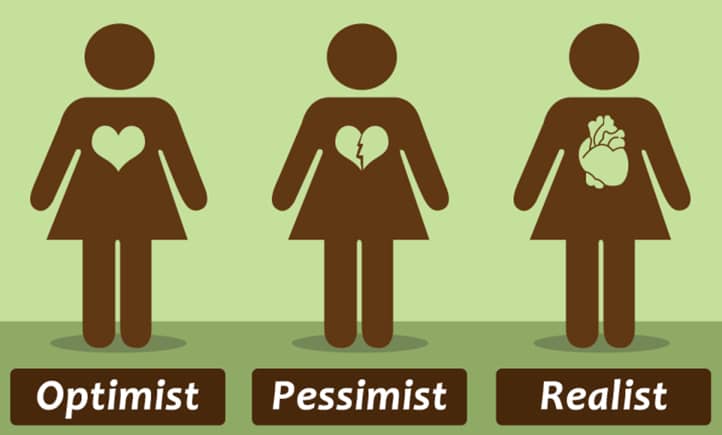Realism as a philosophical and psychological concept has deep roots in the history of human thought. From ancient philosophers to modern psychologists, many thinkers have attempted to understand and describe a realistic approach to life. In psychology, realism is often viewed as an adaptive strategy that helps individuals effectively cope with life’s challenges.

Who is a Realist?
A realist is someone who perceives reality without illusions and exaggerations, approaching life with practicality and common sense. Realists don’t have their heads in the clouds, nor do they plunge into pessimism. They strive to see the world as it is, making balanced decisions based on facts and logic.
Main Characteristics of a Realist
- Objectivity in assessing situations
- Practical approach to problem-solving
- Tendency toward analysis and critical thinking
- Ability to accept both positive and negative aspects of life
- Flexibility in adapting to changing circumstances
The psychological profile of a realist includes traits like rationality, pragmatism, and emotional stability. Realists usually manage stress well since their expectations align with reality, helping them avoid disappointment.
Interestingly, research in cognitive psychology suggests that realists have more developed metacognitive thinking skills. This means they have a better awareness of their own thought processes and can manage them more effectively. This “thinking about thinking” ability allows realists to evaluate their judgments more objectively and adjust them as needed.
Neurobiological Basis of Realism
Modern neuroscience research shows that realistic thinking is associated with activity in certain areas of the brain. In particular, the prefrontal cortex plays a key role in rational thinking and decision-making. Realists exhibit a more balanced activity between the brain’s emotional centers (such as the amygdala) and areas responsible for logical thinking.
Interestingly, studies using functional magnetic resonance imaging (fMRI) have shown that people with realistic thinking exhibit more active interactions between different areas of the brain. This may explain their ability to integrate emotional and rational information to make balanced decisions.

How to Recognize a Realist
A realist can be recognized by several characteristic features in their behavior and thinking. These traits appear in various life situations and help distinguish a realist from an optimist or a pessimist.
Behavioral Traits of a Realist
- Balanced Decisions: Realists do not rush to conclusions, preferring to gather all available information before making a decision.
- Willingness to Compromise: They understand that perfect solutions rarely exist and are willing to find a balance between what is desired and what is possible.
- Moderation in Emotions: Realists rarely go to extremes, maintaining emotional balance in different situations.
- Accountability for Their Actions: They do not blame others for their failures, preferring to analyze their own mistakes.
Thinking and Speech Characteristics
- Logical and consistent in argumentation
- Use of facts and statistics in conversation
- Tendency to critically analyze information
- Caution in making predictions and promises
Research in psycholinguistics shows that realists more often use words related to concrete concepts rather than abstract ideas. They also tend to use conditional constructions, reflecting their readiness to consider various scenarios for the development of events.
Attitude Toward Life Situations
Realists approach life challenges with a pragmatic perspective. They do not expect perfection, nor do they give up in the face of difficulties. Their approach can be described as “prepared for the worst but hopeful for the best.”
Interestingly, studies in stress psychology show that realists usually demonstrate more adaptive stress-coping strategies. They are more likely to use problem-oriented strategies aimed at actively solving issues rather than avoiding or emotionally regulating.

Realism vs. Optimism and Pessimism
The human mind has an amazing ability to interpret reality through different lenses. These lenses form our worldview, determining how we react to life events and make decisions.
Realism, optimism, and pessimism are three fundamental approaches to perceiving the world, each with its unique characteristics and consequences for a person’s life. They influence not only our emotional state but also our actions, relationships with others, and even physical health.
Understanding the differences between these worldviews and their impact on our lives can be a key to a more mindful existence. This knowledge allows us to better understand ourselves and others and to develop more adaptive strategies for overcoming life’s difficulties.
Comparative Analysis of the Three Worldviews
- Optimism:
- Expectation of the best outcome
- Focus on positive aspects
- Risk of underestimating potential problems
- Pessimism:
- Expectation of the worst outcome
- Focus on negative aspects
- Risk of missing opportunities due to excessive caution
- Realism:
- Striving for an objective assessment of the situation
- Consideration of both positive and negative factors
- Balance between caution and willingness to act
Impact on Decision-Making and Life Outcomes
A realistic approach often leads to more balanced decisions and stable outcomes. Unlike optimists, realists are less prone to disappointment from unrealistic expectations. At the same time, unlike pessimists, they don’t miss opportunities due to excessive fears.
Research in cognitive psychology shows that realists make more accurate forecasts regarding future events. This is related to their ability to consider a wide range of factors and avoid cognitive biases common among optimists and pessimists.
Neurochemical Basis of Worldviews
Interestingly, different worldviews are associated with varying balances of neurotransmitters in the brain:
- Optimism is often associated with elevated dopamine levels, explaining the more positive outlook on life and tendency to seek pleasure.
- Pessimism may be linked to increased serotonin activity, which influences perceptions of threats and negative scenarios.
- Realism is characterized by a more balanced ratio of various neurotransmitters, promoting more flexible and adaptive thinking.

Rules of Life for Realists
The life philosophy of realists is not accidental but is shaped by certain principles and beliefs. These rules of life serve as a compass, guiding realists through the turbulent waters of everyday life.
Understanding these life rules not only sheds light on the mindset of realists but also offers valuable lessons for anyone striving for a more balanced and effective approach to life.
Key Principles and Values
- Objectivity in assessing situations
- Acceptance of reality as it is
- Focus on what can be changed
- Willingness to keep learning and adapting
- Value honesty with oneself and others
Research in positive psychology shows that realists often display high levels of psychological resilience. This quality allows them to effectively cope with life’s difficulties and quickly recover after setbacks.
Approach to Problem-Solving
Realists approach problem-solving methodically and rationally. Their typical algorithm includes:
- Clear problem definition
- Collection and analysis of relevant information
- Consideration of different solution options
- Assessment of potential risks and benefits
- Decision-making and implementation
- Analysis of results and lessons learned
Interestingly, this approach largely aligns with the scientific method, making realists effective in solving both personal and professional challenges.
Attitude Toward Goals and Planning
Realists set achievable goals based on an objective assessment of their abilities and external circumstances. They understand the importance of planning but are also willing to adjust their plans according to changing conditions.
Motivation psychology research shows that realists are more likely to achieve their goals thanks to a more accurate assessment of necessary resources and potential obstacles.

How to Live with a Realist?
Interacting with realists can be both inspiring and challenging. Their straightforwardness and practical approach to life can bring stability and clarity to relationships but can also create friction with people who have a different worldview.
The key to harmonious coexistence with realists lies in understanding their motivation and values. Realists don’t aim to hurt others’ feelings or shatter dreams; their goal is to find the most effective and practical solutions to life’s challenges.
Developing empathy and openness to different perspectives can greatly improve communication with realists. This doesn’t mean fully adopting their worldview, but it creates a space for mutual respect and understanding.
Communication and Interaction Traits
- Directness and Honesty: Realists value open communication without ambiguity.
- Fact-based Argumentation: They trust concrete facts more than emotional arguments.
- Willingness for Constructive Criticism: Realists view criticism as an opportunity for improvement.
- Respect for Boundaries: They value personal space and respect others’ boundaries.
Research in interpersonal communication shows that realists often demonstrate a higher level of emotional intelligence, especially in aspects related to understanding and managing emotions.
Potential Challenges in Relationships
- Realists may seem overly pragmatic or cold.
- Their objectivity may be perceived as a lack of empathy.
- Their analytical nature may lead to delays in decision-making.
It is important to note that these challenges often arise from a misinterpretation of realist behavior. Studies indicate that realists are capable of deep emotional connections but express their feelings more reservedly and rationally.
Tips for Harmonious Coexistence
- Appreciate their honesty and straightforwardness.
- Be prepared to provide facts and logical arguments.
- Respect their need for personal space.
- Be open to discussing problems and seeking compromises.
- Remember that behind their reserved demeanor often lie deep emotions.
Relationship psychology research shows that couples where at least one partner demonstrates a realistic approach to life often experience more stable and satisfying relationships in the long term.

Pros and Cons of Realists
A realistic approach to life, like any other philosophy, carries a specific set of advantages and disadvantages. These aspects shape the unique personality profile of a realist, influencing their successes and challenges in various life spheres.
The pros and cons of realism manifest within the context of particular life situations and interactions with the world. What may be an advantage in one case can become a drawback in another.
Advantages of Realistic Thinking
- Ability to make well-considered decisions.
- Less susceptibility to stress from unmet expectations.
- High adaptability to changing circumstances.
- Effective problem-solving for practical issues.
- Stability in achieving long-term goals.
Research in decision-making psychology shows that realists are less affected by cognitive biases like confirmation bias or planning fallacy. This allows them to more accurately assess risks and opportunities, leading to more effective decisions.
Potential Drawbacks and Limitations
- Risk of missing opportunities due to excessive caution.
- Difficulty with spontaneous decision-making.
- Possible underestimation of the emotional component in relationships.
- Tendency toward overanalysis, leading to “decision paralysis.”
- Potential limitations on creative thinking.
Interestingly, studies in creativity show that some realists demonstrate high levels of creativity, particularly in the practical application of ideas.
Impact on Personal and Professional Life
In the professional realm, realists often succeed due to their reliability and problem-solving abilities. They handle management tasks and long-term planning effectively.
Research in organizational psychology suggests that teams with realists are more likely to achieve goals and manage crises well. Realists often play the role of a “anchor,” balancing excessive optimism and pessimism within the team.
In their personal lives, realists can establish stable, reliable relationships built on mutual respect and understanding. However, they may sometimes lack romantic spontaneity, which could create challenges in the emotional realm.
Relationship psychology research indicates that couples with one realist and one optimist often have high relationship satisfaction. Such partnerships tend to complement each other, balancing practicality and enthusiasm.

How to Foster Realism?
Developing a realistic worldview is a complex process that begins in early childhood and continues throughout life. It involves cultivating critical thinking, emotional intelligence, and the ability to assess situations objectively.
The role of parents and educators in this process is invaluable. They create an environment in which children learn to analyze information, make thoughtful decisions, and cope with setbacks. However, the goal is not to create the “ideal realist” but rather to nurture a balanced personality.
Raising a realist requires a balance between building practical skills and nurturing the ability to dream. This means teaching children to see the world as it is while retaining hope for improvement.
Role of Parents and Environment
- Modeling a realistic approach to life situations.
- Open discussions about problems and their solutions.
- Encouraging critical thinking and analysis.
- Developing emotional intelligence alongside logical thinking.
Research in child psychology shows that children whose parents demonstrate a realistic life approach are more likely to develop effective problem-solving skills and cope better with stress in adolescence and adulthood.
Methods to Develop Realistic Thinking in Children
- Encouraging curiosity and questioning.
- Teaching information analysis and fact-checking.
- Developing planning and goal-setting skills.
- Discussing the consequences of different choices and actions.
- Fostering responsibility for their actions.
Interestingly, educational programs based on critical thinking and scientific methods have proven effective in fostering realistic thinking in children and adolescents.
Balancing Realism with Other Life Approaches
It’s important to remember that the goal is not to raise a “pure” realist but to foster a balanced personality. Therefore, it’s essential to:
- Encourage creativity and imagination alongside logical thinking.
- Teach children to appreciate the emotional aspects of life.
- Foster the ability to dream and set ambitious goals.
- Develop flexibility of thought and adaptability to different situations.
Research in positive psychology indicates that individuals who blend realism with elements of optimism often demonstrate high psychological well-being and resilience.

Realism in Various Life Spheres
A realistic approach finds application in a wide range of human experiences. From career and finances to personal relationships and creativity, realism can serve as a reliable compass for navigating complex life paths.
In the professional realm, realism aids in setting achievable goals, managing resources effectively, and making informed decisions. It balances ambition with practical limitations, often leading to sustainable success.
In personal life, a realistic outlook contributes to healthy relationships based on mutual respect and understanding. Realists are inclined to openly discuss issues and seek constructive solutions, which can strengthen interpersonal bonds.
Applying a Realistic Approach at Work
- Effective project planning with consideration of potential risks.
- Objective assessment of one’s and others’ abilities when assigning tasks.
- Making informed decisions based on data analysis.
- Ability to adapt to market or organizational changes.
- Constructive conflict resolution and negotiation.
Organizational psychology research indicates that companies led by realists often demonstrate stable growth and handle crises more effectively.
Realism in Personal Relationships
- Setting healthy expectations for one’s partner and the relationship as a whole.
- Ability to acknowledge both the strengths and weaknesses of one’s partner.
- Effective resolution of everyday issues and financial matters.
- Open discussion of issues and finding compromises.
- Building long-term, stable relationships.
Realistic Self-Perception
- Objective evaluation of one’s strengths and weaknesses.
- Setting achievable personal growth goals.
- Accepting one’s limitations and working to overcome them.
- Ability to learn from mistakes and setbacks.
- Balancing self-criticism with self-acceptance.
Personality psychology research shows that people with a realistic self-view often demonstrate higher self-efficacy and psychological well-being.

Realism and Mental Health
The relationship between realistic thinking and mental health is a nuanced and complex topic. While optimism has long been associated with better psychological well-being, recent research offers a more detailed picture.
A realistic approach can serve as a protective factor against some mental disorders. The ability to objectively assess situations and one’s own abilities may reduce the risk of anxiety and depression associated with unrealistic expectations or pessimism.
However, excessive realism that borders on cynicism can negatively affect mental health. Striking a balance between realistic assessments and maintaining hope for a positive future is key.
Depressive Realism
The concept of “depressive realism,” introduced by psychologists Lauren Alloy and Lyn Abramson in 1979, suggests that individuals with mild or moderate depression may assess reality more accurately than healthy individuals. This contradicts the common view that depression always involves distorted perceptions of reality.
Later studies have shown limitations to this theory, indicating it cannot be universally applied. However, it underscores the importance of realistic evaluation for mental health.
Realism and Stress Resilience
Studies indicate that a realistic approach can enhance stress resilience. Realists are generally better prepared for challenges as they:
- Avoid excessive expectations that could lead to disappointment.
- Plan and prepare for potential problems more effectively.
- Quickly adapt to changing circumstances.
Realism and Coping Strategies
Coping strategies are methods by which individuals manage stress and difficult situations. Research shows that realists are more likely to use adaptive coping strategies, such as:
- Active problem-solving.
- Seeking social support.
- Positive reevaluation of situations.
These strategies are linked to better psychological well-being and a lower risk of developing mental health disorders.

Realism in the Context of Cultural Differences
The perception and value of realism vary significantly depending on cultural context. What may be seen as healthy realism in one culture could be viewed as pessimism or lack of ambition in another.
These cultural differences in attitudes toward realism have deep historical and philosophical roots. They reflect different approaches to understanding the nature of reality, the individual’s role in society, and attitudes toward the uncertainty of the future.
In today’s globalized world, understanding these cultural nuances is increasingly important. It allows for more effective interaction with people from different cultures, avoiding misunderstandings and conflicts rooted in different perceptions of reality.
Western and Eastern Cultures
In Western cultures, especially in the U.S., optimism is traditionally highly valued. However, in some Eastern cultures, such as Japan or China, a more realistic or even slightly pessimistic view of life is common.
Research shows that these cultural differences can impact:
- Goal-setting and life expectations.
- Ways of coping with stress.
- Attitudes toward success and failure.
In the modern globalized world, a realistic approach is an essential tool for cross-cultural interaction. Realists who can objectively assess and adapt to cultural differences may find greater success in international contexts.

Conclusion
So, what defines a realist? It’s someone who strives to see the world as it is, without excessive optimism or pessimism. Realists value practicality, common sense, and objectivity, allowing them to solve problems effectively and achieve their goals.
A realistic approach has its advantages and disadvantages. On the one hand, it aids in making well-informed decisions and avoiding disappointment from unmet expectations. On the other hand, excessive realism can limit creative thinking and the ability to dream.
It’s important to remember that realism is not merely an inherent character trait but a skill that can be developed and refined. Fostering realistic thinking in children and self-education in adults can lead to a more adaptive and effective approach to life.
In today’s world, full of uncertainty and rapid change, a realistic approach can become a valuable tool for navigating life. It maintains a balance between optimism and pessimism, helping to find practical solutions to problems and achieve set goals.
However, it is important to remember that the ideal approach to life often lies in a flexible combination of different worldviews. Realism, supplemented by a healthy dose of optimism and the ability to dream, can be the basis for a full and satisfying life.
Ultimately, the question “Who is a realist?” leads us to a deeper understanding of human nature and the diversity of approaches to life. Recognizing this diversity and developing the ability to adapt your approach to different situations can be the key to personal growth and success in various areas of life.




